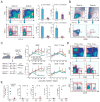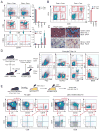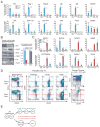Regulation of B versus T lymphoid lineage fate decision by the proto-oncogene LRF
- PMID: 17495164
- PMCID: PMC2978506
- DOI: 10.1126/science.1140881
Regulation of B versus T lymphoid lineage fate decision by the proto-oncogene LRF
Abstract
Hematopoietic stem cells in the bone marrow give rise to lymphoid progenitors, which subsequently differentiate into B and T lymphocytes. Here we show that the proto-oncogene LRF plays an essential role in the B versus T lymphoid cell-fate decision. We demonstrate that LRF is key for instructing early lymphoid progenitors in mice to develop into B lineage cells by repressing T cell-instructive signals produced by the cell-fate signal protein, Notch. We propose a new model for lymphoid lineage commitment, in which LRF acts as a master regulator of the cell's determination of B versus T lineage.
Figures





Comment in
-
Immunology. Keeping a tight leash on Notch.Science. 2007 May 11;316(5826):840-2. doi: 10.1126/science.1143336. Science. 2007. PMID: 17495159 No abstract available.
References
-
- Kondo M, Weissman IL, Akashi K. Cell. 1997;91:661. - PubMed
-
- Maillard I, Fang T, Pear WS. Annu Rev Immunol. 2005;23:945. - PubMed
-
- Medina KL, Singh H. Curr Opin Hematol. 2005 May;12:203. - PubMed
-
- Davies JM, et al. Oncogene. 1999 Jan 14;18:365. - PubMed
-
- Maeda T, et al. Nature. 2005 Jan 20;433:278. - PubMed
Publication types
MeSH terms
Substances
Grants and funding
LinkOut - more resources
Full Text Sources
Other Literature Sources
Medical
Molecular Biology Databases

